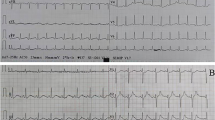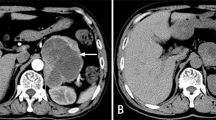Summary
A myocardial infarction is a rare complication of a pheochromocytoma. A pheochromo-cytoma crisis may occur spontaneously, during pregnancy, or may be induced by a local trauma of the tumor or by drugs. We present a case report of a 41-year-old woman without anamnestic episodes of hypertension or angina pectoris. During angiography of the mesenteric arteries for further diagnostics of a sonographically suspected liver tumor, she developed an acute pulmonary edema and a cardiogenic shock with the electro- and echocardiographic findings of a large anterolateral-apical-diaphragmal myocardial infarction. The immediate coronary angiography 90 min after the onset of the myocardial infarction showed normal coronary arteries with normal coronary blood flow of the arteries supplying myocardial areas with akinetic segments and those arteries supplying hyperkinetic segments. The blood catecholamine levels at this time were excessively elevated. The left ventricular function improved to almost normal within the next 4 weeks with the beginning of the improvement already before the abdominal tumor was surgically removed at day five. The histology documented a pheochromocytoma with acute necrosis. The early invasive findings support the hypothesis that a reversible spasm of several epicardial arteries and not a direct toxic effect of catecholamines could have been the cause of the small myocardial infarction and the observed large myocardial stunning.
Zusammenfassung
Ein Myokardinfarkt ist eine seltene Komplikation einer Phäochromozytom-Krise. Ausgelöst werden solche Krisen im Rahmen einer Schwangerschaft, durch lokale Traumatisierung des Tumors, medikamentös oder spontan. Wir stellen einen Fall einer 41-jährigen Patientin mit unauffälliger Anamnese vor, bei der eine angiographische Abklärung eines sonographisch vermuteten Lebertumors zu einem akuten Lungenödem mit kardiogenem Schock und dem elektro- und echokardiographischen Bild eines großen Vorderwandinfarktes führte. Eine umgehend durchgeführte Koronarangiographie zeigte 90 Minuten nach Infarktbeginn unauffällige Koronargefäße mit normalem Flussverhalten sowohl von Gefäßen, die große akinetische Myokardareale versorgten, als auch von Gefäßen, die hyperkinetische Ventrikelabschnitte versorgten. Die Blutkatecholaminspiegel zu diesem Zeitpunkt waren exzessiv erhöht. Die Ventrikelfunktion erholte sich innerhalb der nächsten 4 Wochen mit Beginn der Erholung noch vor der operativen Entfernung des 15 cm großen Tumors, der histologisch einem Phäochromozytom mit frischen Nekrosen entsprach. Die frühen invasiven Befunde stützen die Hypothese, dass ein vorübergehender massiver Spasmus mehrerer epikardialer Koronargefäße und nicht eine direkt myokardtoxische Katecholaminwirkung zu einer ausgedehnten prolongierten postischämischen Dysfunktion und einem kleinen Myokardinfarkt geführt haben dürfte.
Similar content being viewed by others
Author information
Authors and Affiliations
Additional information
Eingegangen: 4. Juli 2000 Akzeptiert: 13. November 2000
Rights and permissions
About this article
Cite this article
Mauser, M., Billmann, P. & Fleischmann, D. Akuter Myokardinfarkt bei der Phäochromozytom-Krise Frühe koronarangiographische Befunde und echokardiographischer Verlauf. Z Kardiol 90, 297–303 (2001). https://doi.org/10.1007/s003920170177
Issue Date:
DOI: https://doi.org/10.1007/s003920170177




